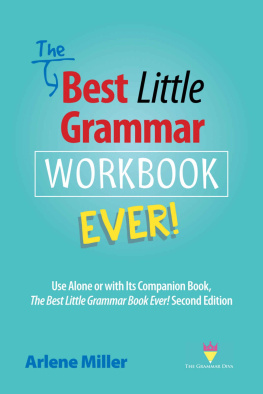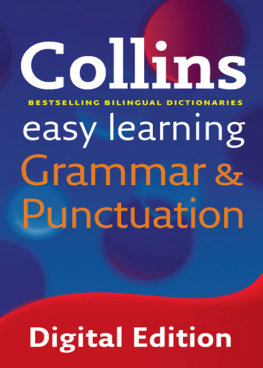Other books by Arlene Miller
The Best Little Grammar Book Ever: Ways to Impress with Your Writing and Speaking
Correct Me If Im Wrong: Getting Your Grammar, Punctuation, and Word Usage Right
The Great Grammar Cheat Sheet:
Grammar, Punctuation, Writing, and Word Usage Tips You Can Use Now (ebook)
The Best Grammar Workbook Ever!
Grammar, Punctuation, and Word Usage for Ages Through
Copyright 2015 by Arlene Miller
All rights reserved. No part of this book may be reproduced or transmitted in any form or by any means, electronic, mechanical, photocopying, recording, or otherwise without the prior written permission of the copyright holder.
Cover design by Matt Hinrichs
Interior design by Marny K. Parkin
Publishers Cataloging-in-Publication Data
Miller, Arlene.
The Best Grammar Workbook Ever! Grammar, Punctuation, and Word Usage for Ages
Through First Edition, 2015
p. cm.
Includes appendixes and index
ISBN 978-0-9911674-0-1 (paperback)
ISBN 978-09911674-1-8 (ebook)
English languageGrammar. English languageUsage. English languageGrammar
Self-instruction
Library of Congress: PE 1106.M550 2015
Dewey: 428.2
Published by bigwords101
website and blog: www.bigwords101.com
Contact Ingram or the publisher for quantity discounts for your company, organization, or educational institution.
To Jake and Shelley,
my two magna opera
Contents
Acknowledgments
Introduction
How to Use This Book
Conventions Used in This Book
Pretest
Chapter The Parts of Speech
1.1. Introduction
1.2. Nouns
The Five Types of Nouns
Practice 2Recognizing Types of Nouns
1.3. Pronouns
Antecedents
Practice 3Pronouns and Antecedents
Types of Pronouns
Practice 4Personal Pronouns
Practice 5Demonstrative Pronouns
Practice 6Interrogative Pronouns
Practice 7Relative Pronouns
Practice 8Intensive/Reflexive Pronouns
Practice 9Indefinite Pronouns
Practice 10Pronoun Review
Brain Challenge
1.4. Verbs
Action Verbs
Practice 11Action Verbs
Linking Verbs
Practice 12Linking Verbs
Practice 13Action and Linking Verbs
Tenses
Practice 14Verb Tenses
Irregular Verb Forms
Practice 15Regular Verbs
Voice
Practice 16Active and Passive Voice
Transitive/Intransitive
Practice 17Transitive and Intransitive Verbs
1.5. Adjectives
Special Types of Adjectives
Practice 18Identifying Adjectives
1.6. Adverbs
1.7. Prepositions
1.8. Conjunctions
Subordinating Conjunctions
Practice 23Identifying Subordinating Conjunctions
1.9. Interjections
1.10. Using the Parts of Speech
Chapter Test The Parts of Speech
Chapter Sentences
2.1. Introduction: What Is a Sentence?
2.2. Subjects
Complete Subjects
2.3. Predicates
2.4. Objects
Direct Objects
Practice 28Identifying Direct Objects
Indirect Objects
Practice 29Identifying Indirect Objects
Objects of a Preposition
Practice 30Identifying Objects of Prepositions
2.5. Predicate Words
2.6. The Four Kinds of Sentences
Declarative Sentence
Interrogative Sentence
Imperative Sentence
Exclamatory Sentence
Practice 32Identifying the Types of Sentences
Chapter Test Sentences
Chapter Phrases
3.1. Introduction: What Is a Phrase?
3.2. Prepositional Phrases
3.3. Infinitive Phrases
3.4. Participial Phrases
Present Participles
Past Participles
Practice 36Identifying Participles
3.5. Gerundial Phrases
3.6. A Few Words About Appositives
Chapter Test Phrases
Chapter Clauses
4.1. Introduction: What Is a Clause?
4.2. Independent Clauses
4.3. Subordinate (Dependent) Clauses
Adjective Clauses
Practice 42Identifying Adjective Clauses
Adverb Clauses
Practice 43Identifying Adverb Clauses
Noun Clauses
Chapter Test Clauses
Chapter Types of Sentence Structures
5.1. Introduction
5.2. Not a Sentence
Sentence Fragment
Practice 44Identifying and Rewriting Sentence Fragments
Run-on Sentences
Practice 45Identifying and Correcting Run Ons
5.3. Types of Sentence Structures
Simple Sentence
Compound Sentence
Practice 46Simple and Compound Sentences
Complex Sentence
Practice 47Complex Sentences
Compound-Complex Sentence
Practice 48Identifying Sentence Structures
5.4. A Variety of Sentence Patterns
Chapter Test Types of Sentence Structures
Chapter Special Issues with Pronouns
6.1. Introduction
6.2. Personal Pronoun Problem: CasesIs It I or Me?
6.3. Demonstrative Pronouns and Adjectives: This, That, These, Those
6.4. Reflexive Pronouns: Using the -self Words Correctly
6.5. Interrogative Pronoun Issues
Whose or Whos?
Practice 54Whose and Whos
6.6. Relative Pronouns: Using Who, Which, and That Correctly
6.7. Indefinite Pronouns: Singular or Plural?
Singular Indefinite Pronouns
Practice 56Singular Indefinite Pronouns
Plural Indefinite Pronouns
Indefinite Pronouns That Can Be Either Singular or Plural
Practice 57Indefinite Pronouns
6.8. Unclear Antecedents
Chapter Test Special Issues with Pronouns
Chapter Special Issues with Verbs
7.1. Introduction
7.2. Tense
Tense Trouble
Using the Past Perfect
Practice 59Using Correct Tenses
7.3. Irregular Verb Forms
7.4. Verbs of Being
Adjectives After Linking Verbs
Pronouns After Linking Verbs
7.5. Voice: Active or Passive?
7.6. What Is Subjunctive Mood, Anyway?
Commands and Recommendations
Things That Are Not True
Practice 62Using Subjunctive Mood
7.7. Using Strong Verbs
Chapter Test Special Issues with Verbs
Chapter Commas: Yup! A Whole Chapter
8.1. To Comma or Not To Comma: That Is the Question
8.2. Series Comma (Oxford Comma)
8.3. Compound Sentences
8.4. Between Two Adjectives
8.5. Introductory Elements
Introductory Words and Transition Words
Introductory Phrases
Introductory Clauses
8.6. Interrupting Material
Commas Needed
No Commas Needed
Practice 64Commas for Introductory and Interrupting Elements
8.7. Other Common Uses for Commas
etc., i.e., e.g.
Dates
Commas with Numbers
With Too
Direct Address
Setting off Academic Degrees













